
DESERTIFICAÇÃO EM GILBUÉS – PI: DEGRADAÇÃO DOS SOLOS, IMPACTOS ECONÔMICOS E SOCIOAMBIENTAIS
A desertificação é um dos maiores problemas ambientais do mundo na atualidade. Nesse sentido, pretende-se estudar a história da desertificação em Gilbués, localizado no sudoeste piauiense, numa região de transição entre a caatinga e o cerrado. O início da degradação dos solos na região começou nos anos de 1940 e 1950, embora existam registros de fragilidades ambientais desde a segunda metade do século XIX. O objetivo do trabalho é demonstrar as possibilidades de se estudar o processo de desertificação em Gilbués a partir da teoria e da metodologia da história ambiental, pensando a partir das interações entre sociedade e natureza ao longo do tempo. A pesquisa, parte dos pressupostos da história ambiental, pressupõe três níveis: 1) investigar os recursos naturais existentes na área de estudo; 2) analisar as relações socioeconômicas da sociedade com o ambiente ao longo do tempo; 3) compreender as manifestações culturais resultantes das interações do homem com a natureza. Neste ensaio, do ponto de vista metodológico, utilizar-se-á as duas primeiras dimensões. Para tanto, serão apresentados os principais teóricos dessa nova abordagem historiográfica e far-se-á revisão de literatura sobre o fenômeno da desertificação.
DESERTIFICAÇÃO EM GILBUÉS – PI: DEGRADAÇÃO DOS SOLOS, IMPACTOS ECONÔMICOS E SOCIOAMBIENTAIS
-
DOI: 10.22533/at.ed.3931923096
-
Palavras-chave: Sociedade e Natureza. Degradação Ambiental. Desenvolvimento Sustentável.
-
Keywords: Society and Nature. Environmental Degradation. Sustainable Development.
-
Abstract:
Desertification is one of the biggest environmental problems in the world nowadays. Regarding this information, we intend to study the history of the desertification in Gilbués, located in southwestern Piauí, in a transition region between the caatinga and the cerrado. The beginning of the soil degradation in the region was on the 1940s and 1950s, although there are records of slight weaknesses since the second half of the 19th century.The objective of this paper is to demonstrate the possibilities of studying the process of desertification in Gilbués from the theory and methodology of environmental history, thinking about the interactions between society and nature over time. The research, based on the assumptions of environmental history, presupposes three levels: 1) investigating the natural resources in the area of study; 2) analyzing the socioeconomic relationship between the society and the environment over time; 3) understanding the cultural manifestations resulting from man’s interactions with nature. In this paper, from the methodological point of view, the first two dimensions will be used. In order to do so, the main theorists of this new historiographic approach will be presented and also a literature review will be done on the phenomenon of desertification.
-
Número de páginas: 15
- Maria do Socorro Lira Monteiro
- Dalton Melo Macambira


